![]()
![]()
![]()
Use LEFT and RIGHT arrow keys to navigate between flashcards;
Use UP and DOWN arrow keys to flip the card;
H to show hint;
A reads text to speech;
25 Cards in this Set
- Front
- Back
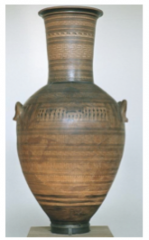
|
Name: Athens 804, Amphora Artist: Dipylon Workshop Location: Medium: Amphora Date & Period: ca. 750 BCE, Geometric Importance: Appearance of people (Prothesis) on geometric vases. |
|
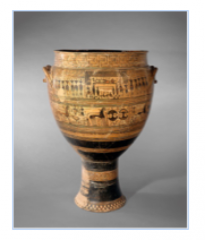
|
Name: Terracotta Krater Artist: Hirschfeld Workshop Location: MET Medium: Terracotta Date & Period: ca. 750-735 BCE Geometric Importance: Very geometric period. Using more figures |
|
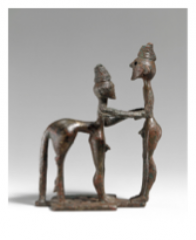
|
Name: Statuette of a Man and Centaur Artist: N/A Location: MET Medium: Bronze Date & Period: ca. 750 BCE; Late Geometric Importance: Small figure. Use of geometric shapes. Just learning how to portray a mythological figure |
|

|
Name: Terracotta neck-amphora (storage jar) Artist: NY Nettos Painter Location: MET Medium: Terracotta Date & Period: 2nd ¼ of 7th Century; Orientalizing Importance: Representing more mythology. Lots of design. |
|
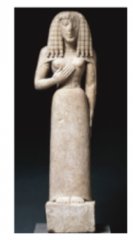
|
Name: Auxerre Goddes Artist: N/A Location: Medium: Limestone statuette Date & Period: ca. 630 BCE; Orientalizing Importance: Daedalus type. Trying to show the shape of the body. |
|
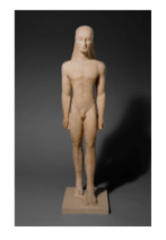
|
Name: New York Kouros Artist: N/A Location: MET Medium: Marble, Naxian Date & Period: 590-580 BCE; Archaic Importance: Started free standing, full size instead of small ones. Learning how to carve large sculpture. //influenced by the Egyptians, begun to cut away stone, free him from the stone, more and more they learn how to model. |
|

|
Name: Anavysos Kouros Artist: N/A Location: Medium: Marble Date & Period: 530 BCE; Archaic Importance: Introduction of the Archaic smile. Getting better at modeling of the body. |
|

|
Name: Peplos Kore Artist: N/A Location: Athenian Acropolis Medium: Marble Date & Period: 530 BCE; Archaic Importance: An improvement on how to model the human figure. Still use of Archaic smile. |
|
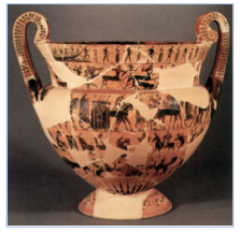
|
Name: Francois Vase Artist: N/A Location: Chiusi, Etruria Medium: Vase (volute crater) Date & Period: 570 BCE; Archaic Importance: All myth across the entire vase. Mythological stories take off. |
|
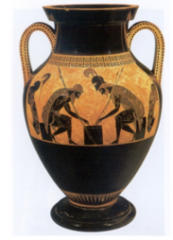
|
Name: Achilles & Ajax Playing Dice Artist: Exekias Location: N/A Medium: Amphora Date & Period: 540 BCE; Archaic Importance: Height of Black figure. A moment before the action. Very intricate. |
|
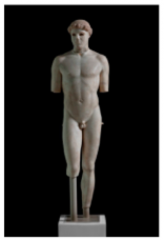
|
Name: Critian Boy Artist: N/A Location: Athenian Acropolis Medium: Marble Date & Period: 480 BCE; Archaic Importance: Beginning of the contrapostal pose. Body is more relaxed. Not as frontal—head and body slightly turned. |
|
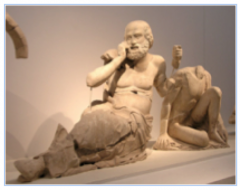
|
Name: The Seer Artist: N/A Location: Pediment; Temple of Zeus at Olympia Medium: Marble Date & Period: 460 BCE; Classical Importance: Started to have more emotions, old people, and forms. |
|
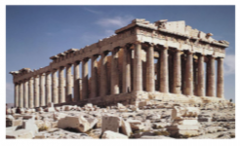
|
Name: Parthenon Artist: Ictinus, Callicrates Location: Athens, Greece Medium: Date & Period: 447-432 BCE; High Classical Importance: |
|

|
Name: Birth of Athena Artist: N/a Location: East Pediment of Parthenon Medium: Sculpture Date & Period: 435 BCE; High Classical Importance: Body is truly modeled. |
|
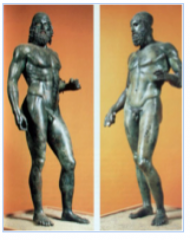
|
Name: Riace Bronze Artist: N/A Location: Italy Medium: Bronze Date & Period: 460-450 BCE; Early Classical Importance: Moving in the direction of the contrapostal. Twisting of the body and more form. |
|
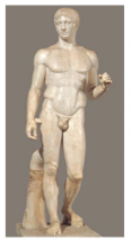
|
Name: Doryphorus (spear-bearer) Artist: Polyclitus Location: Naples Medium: Marble Date & Period: 440 BCE; High Classical Importance: Canon, bodily proportions. Contrapostal pose. |
|
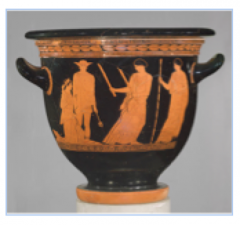
|
Name: Return of Persephone Artist: Attributed to the Persephone Painter Location: Greek, Attic Medium: Terracotta Date & Period: 450 BCE; High Classical Importance: No emotion in the face, the movement, the drapery is natural. |
|
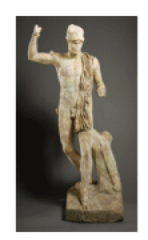
|
Name: Marble Statue of Wounded Warrior Artist: N/A Location: MET Medium: Marble Date & Period: 450 BCE; High Classical Importance: A pose that’s sort of derivative of the contrapostal pose. No emotion on the face. Caught in action. |
|
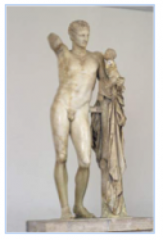
|
Name: Hermes with Dionysus Artist: Praxiteles Location: Olympia Medium: Marble Date & Period: 340 BCE; Late Classical Importance: Moving in a different direction. Thinner proportions. Stance that’s a little more off kilter. More s-shaped posture. |
|
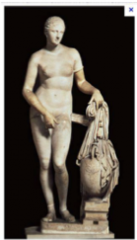
|
Name: Aphrodite of Cnidus Artist: Praxiteles Location: Vatican Medium: Marble Date & Period: 350 BCE; Late Classical Importance: Now representing women/god in the nude. |
|
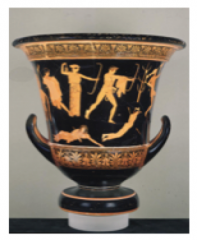
|
Name: Calyx Crater Artist: Niobid Painter Location: Louvre Medium: Vase (crater) Date & Period: 460 BCE; Early Classical Importance: The individual ground line. |
|
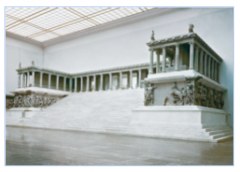
|
Name: Great Alter at Pergamon Artist: Phyromachos; King Eumenes II Location: Pergamon (Acropolis) Medium: Date & Period: 180 BCE; Hellenistic Importance: Lots of movement in the reliefs. Lots of emotions. Pathos. |
|

|
Name: Athena Fighting the Giants (Great Alter of Pergamon) Artist: Phyromachos? Location: Pergamon Medium: Marble? Date & Period: 180 BCE; Hellenistic Importance: Movement going everywhere from all of the characters. Drapery follows the body. Deep emotions. Mouths are open now. |
|
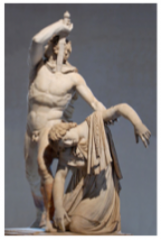
|
Name: Gaul Killing Himself and Wife Location: Pergamom Medium: Marble Date & Period: 3rd Century (220) BCE; Hellenistic Baroque Importance: Full of Emotion and realism. Having many views. Twisting the bodies/torsion. // Alexander the Great conquered the known world, has lots of influence on the art. |
|
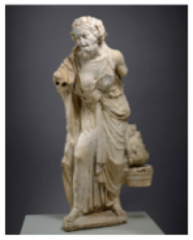
|
Name: Old Market Woman Artist: N/A Location: MET Medium: Marble Date & Period: Original, late 2nd c. BCE Hellenistic Importance: These would have been painted. Seeing different positions of her. More naturalistic direction |

